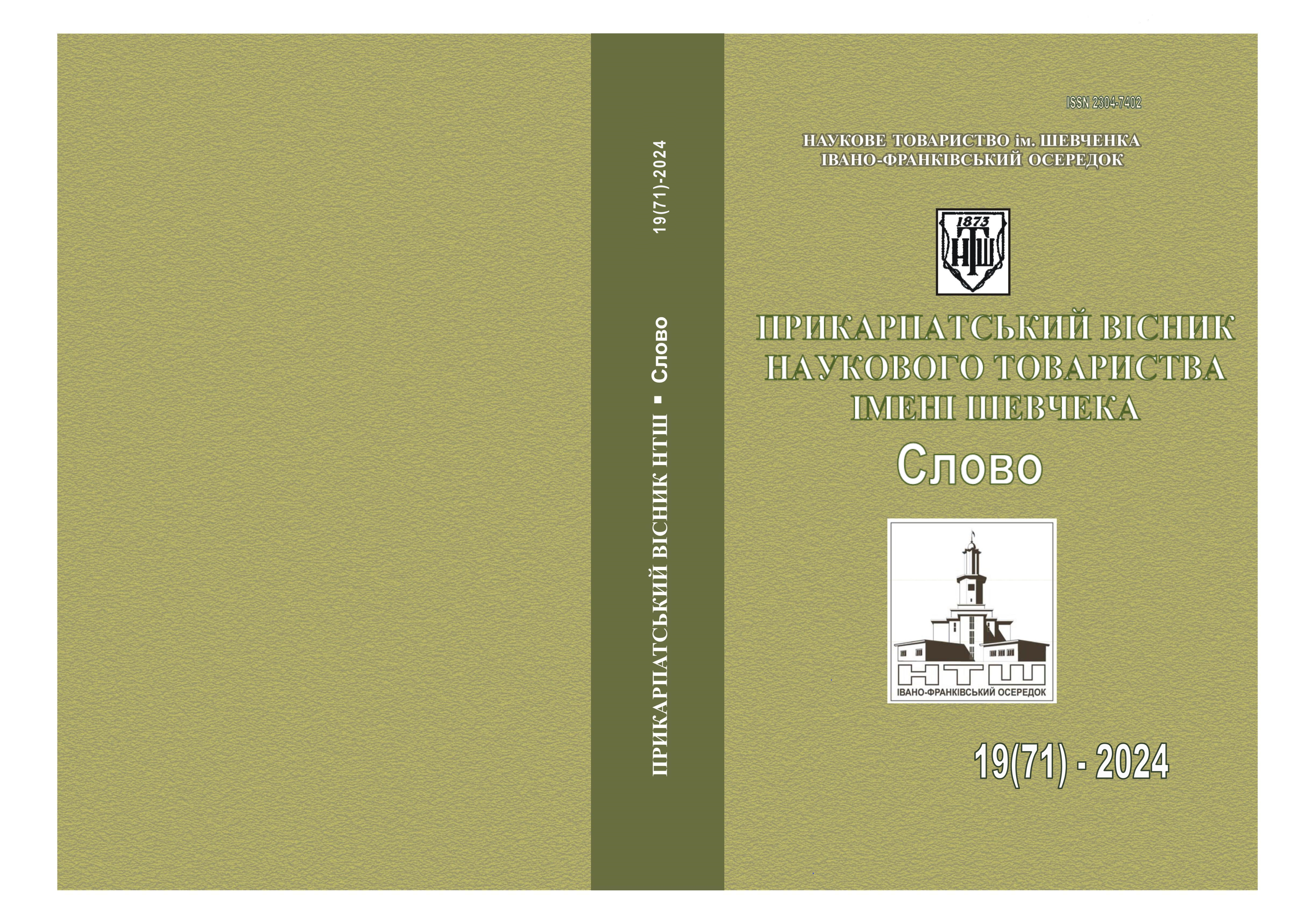NATIONAL FORMS OF BODY ICONOTROPIZATION IN MODERN POLISH AND UKRAINIAN ARTISTIC DISCOURSE
DOI:
https://doi.org/10.31471/2304-7402-2024-19(71)-178-192Abstract
The article examines the forms of bodily iconotropization through the prism of their representation in national ethnic codes embodied in contemporary Polish and Ukrainian postmodern discourse. The object of the research is the novel "Solodka Darusia" by Maria Mathios and "Pravik and other times" by Olga Tokarchuk. The selected works make it possible to explore the topic in detail, since the representations of the physical characters in both novels are connected with the national matrix and the characteristic ethnocode of Polish and Ukrainian cultures. The subject of analysis is the bodily elements of the heroes represented in the novels. Among the research methods - comparative, which in our research is based on the comparison of selected novels in the context of the national characteristics of Polish and Ukrainian culture. The comparative method is relevant in the study of postmodern literature, because in the modern world globalization brings cultures closer together. We can determine the important role of the hermeneutic approach in the study of the poetics of iconotropism in the work of the selected women writers, in particular the integrity of images, since both novels tell about the period from the beginning of the 20th century, but nevertheless with a projection on the modern world. Also important are the formal and typological methods that contribute to the determination of the systemic, structural principles of bodily iconotropism in the Ukrainian and Polish literary traditions.
As a result, on the basis of the selected novels, a two-way connection between the body and the national can be traced, which in a certain way iconotropizes the "body of the nation". Similar and distinctive features of the iconotropization of body elements in the characters' images are analyzed. Such an analysis helps to trace the iconic-conventional features of ethnic semiotics in a specific context. The identified tasks and conclusions are relevant for modern trends in European science. Having analyzed individual aspects of the investigated problem, we can conclude that national physicality is a complete system. This is due to cultural traditions, religious beliefs and historical background. The analysis of the iconotropism of corporeality through the prism of representation in national ethnic codes, embodied in creativity, provides a deeper understanding of the relationship between the internal and external levels. We see a certain similarity between the Polish and Ukrainian nations in the intentions of iconotropization of such an abstract element as the soul, which is connected with the dominance of religion in the cultural environment of both nations. We also trace the important role of the relationship between nature and the human body. In the Ukrainian and Polish national consciousness, nature is perceived as a separate living organism from which man draws strength and energy. Instead, the embodiment of the female braid in Ukrainian literature, which is a consequence of the traditional worldview, seems to be excellent. Such an analysis helps to trace the ethnic characteristics of a certain community. Such scientific research is extremely important in the light of modern trends in European culture.
References
Башкирова O. Тілесність як простір смерті й відродження у романістиці Любка Дереша. Літературний процес: методологія, імена, тенденції. Збірник наукових праць (філологічні науки). Київ: Київський університет імені Бориса Грінченка, 2017. № 10. С. 10 - 17.
Васильків Г. М. Когнітивні сфери іконотропізму. Прикарпатський вісник Наукового товариства імені Шевченка. Слово, 2022. № 17(65). С. 362-371.
Гайович Г. Тілесність як один із репрезентантів культурного коду українців, 2016.
URL:https://www.academia.edu/41559296/Ciało_i_tożsamość_w_ukraińskiej_kulturze_sztuce_literaturze_języku
Гомілко О. Метафізика тілесності: концепт тіла у філософському дискурсі. К.: Наук.думка, 2001. 340 с.
Декарт Рене. Метафізичні розмисли. Пер. з фр. З.Борисюк та О.Жупанського. Київ: Юніверс, 2000. 304 с.
Калько В. В. Лінгвокультурний аналіз соматизму язик в українських пареміях. Наукові записки Вінницького державного педагогічного університету імені Михайла Коцюбинського. Серія Філологія (мовознавство), 2012. №16. С.135-140.
Климентова О.В. Тіло як сакральний концепт в українських молитвах. Матеріали Інтернет-конференції «Тіло й ідентичність в українській культурі, мистецтві, літературі, мові». Варшава – Івано-Франківськ, 2016. С. 145-152.
Матіос М. Солодка Даруся: драма на три життя. Роман. Київ: А-БА-БА-ГА-ЛА-МА-ГА, 2022. вид. 4-те. 208 с.
Найдьонова Г. Проблема тілесності в психології та філософії. Філософія гуманітарного знання: раціональність і духовність. Матеріали наукової конференції 2-3 жовтня 2008 р. Чернівці: Рута, 2008. 472 с.
Попович М. В., Кисляковська І. В., Вяткіна Н. Б. "Проблеми теорії ментальності". Київ: Наукова думка, 2006. 406 с.
Скуратівська Г. Ментальні основи української культури: концепти національної ідентичності. Літературознавство. Фольклористика. Культурологія, 2015. № 18-20. С.16-21.
Солецький О.М. Емблематичні форми дискурсу: від міфу до постмодерну: монографія. Івано-Франківськ: «Лілея-НВ», 2018. 400 с.
Терендій Т. В. Вбрання та прикраси польської шляхтянки XVI-XVII ст. Україна у світовому історичному просторі: збірник матеріалів Всеукраїнської науково-практичної конференції. Маріуполь: МДУ, 2017. С. 220 – 222.
Токарчук О. Правік та інші часи. Роман. Львів: Кальварія, 2004. 224 с.
Шухевич В. Гуцульщина. Львів, 1902. Ч. 3. С. 19.
Ярмоленко Н. Тіло епічного богатиря-козака як мікрокосм. Філологічний часопис. вип. 1, 2015. С. 142-149.
Clement O. Ciało śmiertelne i chwalebne: wprowadzenie do teopoetyki ikony, Warszawa, 1999. S. 8.
Dudziński P. Ciała, wiele ciał – o literackiej i kulturowej konstrukcji ciała na przykładzie powieści Michela Fabera Szkarłatny płatek i biały: Ciało cielesne, red. K. Konarska,Wrocław, 2011. S. 159-164.
Husserl E. Cartesianische Meditationen: Eine Einleitung in die Phänomenologie. Husserliana. Bd. 1. Den Haag: Martinus Nijhoff, 1950. S. 114.
Jakubowska-Krawczyk K., Olechowska P., Romanûk S., Zambrzycka D., Ukrainistyki M., & Warszawski, U. (Eds.). Ciało i tożsamość w ukraińskiej kulturze, sztuce, literaturze, języku. Uniwersytet Warszawski. Katedra Ukrainistyki, 2016. URL:https://www.academia.edu/41559296/Ciało_i_tożsamość_w_ukraińskiej_kulturze_sztuce_literaturze_języku
Jaxa-Rożen H. Sztuka krytyczna jako refleksja nad estetyzacją ciała: Ciało cielesne, op. cit., 2011. URL: https://wuwr.pl/cac/article/view/815/788
Spolsky E. Iconotropism as Representational Hunger: Raphael and Titian. Iconotropism: Turning Toward Pictures, 2010. Р. 23-36. URL: http://dx.doi.org/10.17613/n9aj-jq60

